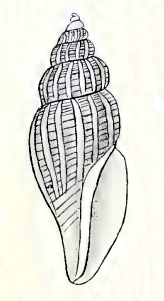Mangelia subaustralis facts for kids
Quick facts for kids Mangelia subaustralis |
|
|---|---|
 |
|
| Original image of a shell of Mangelia subaustralis | |
| Scientific classification | |
| Synonyms | |
|
Mangilia subaustralis Suter, H.H., 1899 |
Mangelia subaustralis is a tiny sea snail that lives in the ocean. It's a type of mollusk, which means it has a soft body, often protected by a hard shell. This particular snail belongs to a group called gastropods, and it's part of the Mangeliidae family.
What Does It Look Like?
This snail has a shell that can grow up to about 11.5 millimeters (less than half an inch) long. Its widest part is about 4.5 millimeters across.
The shell is white and shaped like a spindle, which means it's wider in the middle and tapers at both ends. It has a pointed top, called the spire, which is about the same height as the opening, or aperture.
Shell Features
The shell has distinct patterns. It has raised lines that run lengthwise, called axial ribs. There are about 18 of these ribs on the main part of the shell, known as the body whorl. These ribs are rounded and stand out.
The shell also has fine spiral lines or threads that cross over the axial ribs. These spiral lines are evenly spaced and create a textured surface.
The very tip of the spire, called the protoconch, has about two tiny whorls (turns). The first part is smooth, and the second part has a very fine net-like pattern. The rest of the shell has about six and a half more whorls that are clearly angled, giving the shell a "turreted" or tower-like look.
Opening and Lip
The opening of the shell is quite narrow and angled at the top. It extends into a short, very narrow tube at the bottom, called the siphonal canal.
The outer lip of the shell is thicker because of the last rib. It has a slight curve or shallow dip near the top, just below where the whorls join (the suture). The inner lip is thin and narrow.
Where Does It Live?
This marine snail is endemic to New Zealand. This means it is found naturally only in this specific area and nowhere else in the world. It lives off the coast of Ninety Mile Beach, New Zealand, which is located on the North Island of New Zealand.

